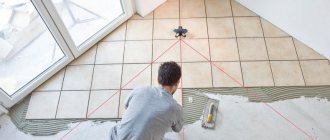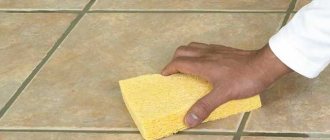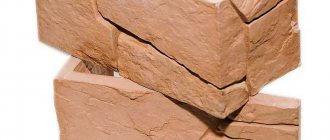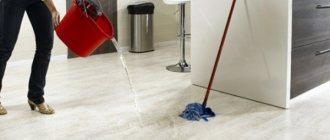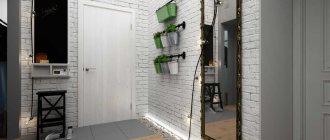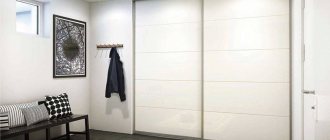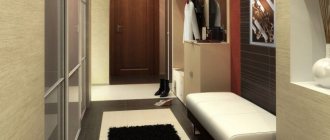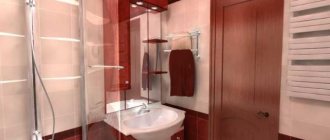When planning a major home renovation, you almost always have to make a difficult choice of the most suitable flooring in front of the front door. Both materials, tiles and laminate in the hallway, look equally good. To determine the best one, you have to spend a long time delving into the network, looking for shortcomings and compromise options. As a result, the combination of tiles and laminate in the hallway is chosen, which in itself is a difficult task for a home designer.
Decorating the hallway with “contrast”
Which is better - tiles or laminate in the hallway?
The easiest way is to do it the old fashioned way, the threshold is made of tiles, and the rest of the hallway floor is finished with laminate. But the design of old schemes already looks rather dull, and most apartment owners would prefer to see a comfortable and at the same time beautiful floor on the floor in the hallway. You can use just one material. Moreover, laminate and tiles have their own strengths:
- The tile is extremely resistant to abrasion, which is especially important for houses and apartments on the first floor, where the exit from the hallway leads directly to the street. A huge amount of dust, salt and sand that gets into the room on the shoes of residents can erase the decorative layer on the floor to the ground in a few months;
- Laminate provides maximum comfort even after rain and snow; drops of water on the laminated floor do not make the coating slippery and traumatic. The slats retain heat well, dampen noise and sounds, while the tiles only reflect and enhance them.
Both types of flooring can be equally effective from both a decorative and utilitarian point of view. If the house does not have a porch area, then the best solution would be to use quartz vinyl tiles or very expensive class 33-34 laminate in the hallway. In all other cases, either laminate flooring or regular tiles can be used.
Advice! You should not compare finishing the corridor with laminate and tiles. Both materials have approximately the same positions, so it is not recommended to buy and install tiles just because you like the color.
It might make sense to try using a combination of tiles and laminate in the hallway. Both materials are available in a huge range of textures and colors. If previously slats were made exclusively with an imitation of wooden or parquet flooring, today there is a huge number of textures of a wide variety of types, from granite to lemon wood. The floor in the hallway made of laminate and tiles, photo, can look very unusual and stylish. At the same time, it remains possible to replace one of the coatings if the design of the room needs to be adjusted or updated.
Classic entrance door design
Characteristics of coatings
Laminate and tile flooring have their advantages and disadvantages. By skillfully combining these two options you can achieve maximum convenience, practicality and beauty.
Laminate and tiles in the kitchen with zoning of the dining area
Laminate
This is a convenient floor covering; its different versions can be used even in rooms with extreme conditions.
Advantages:
- Dirt does not stick to it.
- It serves as a good insulator for the floor.
- Installation does not require special professional skills.
- It is resistant to external factors - abrasion, load, pressure.
- Does not require special care or expensive detergents.
- Durable - when purchasing a 32-33 class coating, you can count on at least 10-15 years of service.
It is also not without its disadvantages, among them:
- When choosing a covering option, for example, for a kitchen or hallway, you need to take into account the class. This has a direct impact on the service life. If you save money, you will have to replace it within a year.
- Strict requirements for the evenness of the base. Differences of no more than 3 mm are allowed.
- Poor “relationship” with moisture. Often, laminate flooring is not designed for installation in rooms with high humidity, so it will not be the best option in the kitchen.
- Creaking, swelling, bubbling are the consequences of improper installation with violation of technology.
- Price. Although the material is considered affordable, in order for it to actually last 10-15 years, it will not be possible to get by with minimal investments.
Contrasting combination of floor coverings
Tile
This material has a lot of advantages: it is attractive, affordable, durable, and also has excellent wear resistance. But tiles, like laminate, can be different, namely:
- Granite is perhaps the best representative of this class of coating. Its technical characteristics are excellent, as is the price.
- Ceramic - cheaper than the first option, but has wear resistance and frost resistance. It is easy to care for as it is resistant to chemicals.
- Tile is a subtype of ceramic tile, used for interior spaces.
Features of the floor in the hallway made of tiles and laminate
Installing a double floor covering is more complicated than conventional laying of tiles or slats, both technically and stylistically. It will be necessary to lay two materials, completely different in structure, material and method of fastening.
In addition, when planning the installation of laminate and tiles in the hallway, you must consider the following:
- Tiles are traditionally placed in the area adjacent to the entrance door threshold. You can cover the rest of the hallway floor with laminate. This is done in order to leave most of the snow, water and sand on the tiled surface, since the laminate needs to be protected as much as possible from exposure to moisture and salt;
- The joint between the tiles and the laminate in the hallway is made hidden; usually there is little space in the hallway and relatively poor lighting, so the absence of a protruding lining adjacent to the slippery tiles will only increase the safety of the room;
- Under the tiles in the hallway you will need to do full waterproofing, and for a private house you will also need insulation. It is best to lay slats on a polystyrene foam backing; it does not absorb moisture and odors, and does not rot if water accidentally leaks into the hallway.
Moisture will enter the room along with street water and water vapor from cold air, so the area in front of the front door has always been the place where wooden floors and thresholds rot the most. Even with very good ventilation, condensation regularly appears on the floor in the hallway. Therefore, the scheme with tiles at the entrance, turning into laminate in the corridor, has become so popular even for ordinary apartments in multi-storey buildings.
Combination of white and chestnut colors
Coverage classes and which is most optimal for the hallway
Laminate has different strength classes. These are categories that determine the degree of resistance to abrasion and mechanical loads.
Today laminates of such classes are produced:
- 31. This is the lowest class, which is used in the mildest conditions - in apartments, small offices with a small number of people. Unable to withstand high loads, but in acceptable conditions it is quite suitable for use.
- 32. Medium strength class, designed for offices or small shops with medium loads. For an apartment it is considered the most acceptable option, as it has a quite decent set of qualities and characteristics at relatively low prices. Class 32 has the widest choice of colors or textures.
- 33. This class is created for the most severe operating conditions, for shops, large offices, and public buildings. For apartments, it has a large margin of safety, but many users prefer to play it safe and buy it. The choice of color or texture is somewhat reduced, since the cost of the material is quite high.
- 34. The highest strength class, which has not yet been finally approved and is used only as an indicator of the highest resistance of the material to all loads without exception. Can be used in airports, concerts, sports or entertainment halls. The prices for such laminate are the highest.
NOTE!
The classification is quite detailed, but does not at all reflect the degree of moisture resistance, so when choosing, you need to clarify the resistance of the laminate to water.
The resistance of laminate flooring to moisture is an important factor. It is noteworthy that this parameter is not directly reflected anywhere; stability can only be assessed by the amount of water absorption, which is usually indicated in the passport or characteristics of the material .
If you are choosing a laminate for the hallway, you can be guided by the base material, for example, HDF is a more water-neutral material, and vinyl is completely indifferent to the effects of water. For the rest, you can be guided by the class of the material and its decorative qualities.
How to choose tiles and laminate for the hallway
The selection of materials for finishing the floor in the hallway is somewhat different from the rest of the apartment or house. Of course, you can choose marble tiles and expensive premium class 34 laminate, but such a solution, even with significant financial expenses, does not always turn out to be the best in practice.
To select the right material, you must adhere to two requirements:
- The combination of tiles and laminate should provide protection from moisture and dirt, and safety in the hallway. Details such as comfort are usually paid less attention to, since the apartment owner spends only 1-5% of their stay in the entrance hallway;
- A professional combination with the interior of the hallway. The floor in the hallway remains an element of the furnishings and design of the entire living space, so you have to look for the most stylish flooring design options.
Important! The floor in the hallway, like the front door, can be called the hallmark of the apartment.
When entering a room, a guest or visitor automatically glances at their feet, so the design style of the corridor, walls and flooring turns out to be an even more powerful argument than the technical characteristics of the same tile or laminate. But any homeowner should have a general idea of what type of slab and slats are installed in the hallway.
Laying tiles in the form of a honeycomb requires the experience of a master.
Choosing a tile
If you are looking for a material with the highest durability, then porcelain stoneware will be the best option. If for the floor in the kitchen or in the hall, on which you walk in slippers or shoes with soft soles, you choose tiles of class III wear resistance, then porcelain stoneware is at least class five. It will last for 30 years of operation, even if the soil near the house is entirely sandy. Unfortunately, such finishing cannot boast of a variety of colors and patterns; usually these are monotonous black, gray, brown tiles with jasper or granite texture.
The optimal tile option for combination with laminate is wear resistance class IV. This is enough to withstand the load from shoes with hard soles and even metal heels. The hardness of tiles is usually chosen within 7 units, this is enough to avoid painting the surface with gravel and ash chips, which are abundant on the streets in winter.
Sometimes soft tiles based on terracotta or sandstone are used for the entrance area in the hallway. The soft, non-slip and at the same time very beautiful porous surface wears out quickly, becomes dirty, and therefore requires constant care.
Selection of laminate coating
For hallways, one type of laminate is suitable, this is a coating of class 33, or in the European classification AC5. The thickness of the melamine or polyurethane film reaches 0.8-1.0 mm, which allows the material to be used even under conditions of severe abrasive wear.
The thickness of the lamella is 10-12 mm, so the material can be laid on a wooden floor even without plywood underlays; you just need to level and sand the joints and lay the underlay in two layers of polystyrene foam.
Vinyl materials
PVC-based tiles and laminates have been used for a long time; they are excellent as flooring in the kitchen, bathroom and even living room. The slabs turn out to be too soft for finishing the entrance to the corridor; the surface quickly becomes covered with scratches and darkens.
Quartsinil is easy to install even for a beginner
You can use vinyl and quartz vinyl laminate. It can be laid directly on the self-leveling floor or screed poured under the tiles. The material does not require insulation or substrates; with regular cleaning of water, PVC lamellas can last no less than a conventional cellulose-based laminate.
Design secrets
In addition to the properties and qualities of floor tiles for the hallway, do not forget about the design (aesthetics), and the design of the room is also very important. The design design shown in the photo shows that you can choose it arbitrarily, use ready-made blanks or experiment with the style or type of materials.
To visually increase the space, you should pay attention to large-sized tiles (the thinning of the space between the joints and the volumetric pattern will create the illusion of a large room). “Cold” monotonous tones will also help increase volume
It is worth noting that the black color absorbs light very well and shows even the smallest damage and scratches. Therefore, it does not apply in such situations
“Cold” monotonous tones will also help increase volume. It is worth noting that the black color absorbs light very well and shows even the smallest damage and scratches. Therefore, it does not apply in such situations.
To create maximum comfort, tiles of soft textures are used (a large number of halftones in the image, one color flows into another and another). Achieving greater volume (depth) can be achieved using additional tricks.
This is due to the fact that the distance between the corners of the diagonal is wider than the opposite sides. The effect of “Spatial Expansion” is created.
Combination with other types of materials (parquet, linoleum, tiles of different sizes and textures) allows for a more sophisticated approach to the design of the hallway.
It is better to cover the place for storing shoes and the front part with the most durable tiles, since in the future these areas will more often than others come into contact with various substances (water, dirt) and experience more serious loads.
To provide greater comfort and coziness, rugs can be placed on the surface of a tiled floor, which, like tiles, will emphasize the chosen style and perform an additional “practical” function.
Before you go and buy materials for decorating a hallway, you need to evaluate its dimensions and the location of individual parts (walls, furniture, lighting). Based on this and taking into account personal wishes, figure out what the room should become.
- First of all, decide on the color scheme and the level of shadows and light.
- After this, develop your own design, think through individual elements, calculating 2-3 options, take measurements of the areas required for updating, look at photo examples in magazines.
- Only then can you safely go to the store and select the necessary materials, focusing on the requirements for quality, type and price.
How to combine tiles and laminate in the hallway
The transition line between the laminate flooring and the tiled surface in a corridor always becomes a source of dust and dirt collection. Therefore, the seam between them is covered with either a plastic or aluminum cover. The joint itself cannot be removed, since its presence provides compensation for the expansion of the lamellas under load.
When choosing a material, you will need to simultaneously select an overlay
The seam can be filled with colored sealant or pressed with a special polymer cord, which hardens after heating. Thus, it is possible not only to get rid of the protruding side, but also to make the transition line less prominent.
Advantages and disadvantages
The first useful feature of the tile is its adaptability to conditions of increased pollution. The smooth surface is also easy to clean. With high-quality and dense installation, the tile covering exhibits increased resistance to impacts and heavy loads. Fireproof properties are guaranteed by the surface structure. For hot regions with a high risk of wildfires, it is important that flames cannot spread on the floor. In addition, the tiles cool the room on the warmest summer days, both in the north and south. Repairing a fragment of a tile composition is much easier than restoring the integrity of alternative types of coatings - another plus. Thanks to environmentally friendly materials, tiles do not pose any threat to human health. Some points are still negative. However, there are not many of them: poor sound insulation, slippery surface, possible violation of integrity due to poor installation.
The finishing materials market has long had tiles with a coating that prevents slipping and reduces other defects to a minimum.
How to combine tiles and laminate in the hallway in color and style
Traditionally, two methods of combining materials are used. The first option assumes that the flooring, slats and tiles will be slightly darker from the colors of the walls and ceiling. With light coffee and cream walls, the floor in the hallway is only a little darker, for example, walnut or chocolate with milk.
The second option involves the use of contrast. For example, with a light laminate part, the tile is chosen dark, almost black. Contrasting couples can use red, white, yellow, coffee and even dark chocolate. Blue, green and blue shades are practically not used in the design of the hallway.
Poor color arrangement
Important! You cannot make the tile and laminate parts of the floor the same color. Firstly, it is unsafe for traffic, and secondly, the appearance of the corridor merges into one spot of color.
Tile texture
There are options for wood, stone, brick, as well as mirror surfaces and imitation minerals. Natural stone tiles will be needed to embody the style of modern and rustic interiors. Tiles with a fine-grained texture and smooth stone pattern will be appropriate in almost any setting. Terracotta tiles imitate a monotonous reddish stone surface. The “ragged stone” texture depicts the surface of a thick, chipped stone. There are also many options for wood. The texture imitating chipped wood is an excellent companion for a loft-style interior. Neat concentric circles on the tiles will harmoniously fit into the “Scandinavian” decor. Mirror tiles, as well as imitation chrome surfaces, are suitable for arranging a beautiful corridor with designer furniture. Such options are also useful for housing in high-tech, glamor and avant-garde styles.
Corridor design with tiles and laminate
The rules for constructing the decoration of the hallway, taking into account the coating, are no different from the general interior planning scheme. The traditional light walls for the corridor are compensated by either dark tiles or laminate darkened to black.
Roman style
If the corridor space is relatively small, then you have to artificially increase the height of the baseboards or supplement them with dark wall panels. The walls and the laminate are separated by a “wooden” edging. This avoids the merging of the wall and floor surfaces.
Contrast of light door and black tiles
The color and tone of the front door should always contrast with the tiled area. If the hallway is spacious enough, then the tiled area can be made with inserts of slabs of different colors, with a patterned edging.
Patterned tile edging
Compatibility of the baseboard with other decorative elements
Laminate and baseboard
Skirting boards and laminate do not have to be the same color. However, a similar palette is desirable, since a sharp contrast between these elements will create unnecessary accents and reduce the attractiveness of the flooring.
Advice! The color of the baseboard should be between the darkest and lightest in the room.
The color of the plinth is selected according to the following criteria:
- plinth of the same shade with laminate;
- baseboards and doors in the same color tone, but contrasting with the floor;
- baseboards and furniture of the same color in contrast with doors and laminate.
Laminate and doors
Most often, laminate is selected not to match the furniture, walls or ceiling, but to match the color of the door.
Rules for compatibility of laminate and doors:
- It is not advisable to match the colors of the laminate and doors. However, this approach is acceptable if the room has other contrasting interior elements. Typically, doors and laminate flooring of the same color are used in small rooms (entrance hall, corridor).
- Light laminate with the same light doors allows you to visually make the room more voluminous.
Below are the rules for harmonious combinations of door colors and floor coverings:
- Brown. Shades vary from light brown to dark chocolate. The rule is: match a darker-colored floor with a door that is 1-2 shades lighter and vice versa. The trim and slopes must match the door. It is recommended to choose furniture a couple of shades lighter. Brown fits perfectly into the classic interior style and Provence.
- Beige. A common color for doors. Suitable for light laminate flooring. A milky beige or white-golden floor color is recommended. In this case, you should not use doors with a reddish tint.
- Walnut. Walnut-colored doors are combined with lighter laminate. In combination with light beech or oak, these doors look sophisticated thanks to the contrast of colors. Dark walnut perfectly emphasizes classic interior solutions.
Ideas for combining tiles and laminate in the hallway
The shape and size of the area under the front door are limited only by the size of the corridor and the owner’s imagination. Most often this is a square or rectangular sector with a clearly defined transition boundary from tile to laminate.
In a long and narrow hallway, you can build a path from multi-colored tiles with a pattern. In this case, the side parts are sewn up with a laminate with a tiled texture.
The perfect combination of materials
In this arrangement, the laminate gets lost in a pile of tiles
Platforms with a curved transition line look very stylish and unusual. This solution allows you to walk along the corridor to the bathroom or toilet without taking off your shoes. Most of the light in the hallway is concentrated on the front door, so too light colors have to be compensated by a dark shoe cabinet.
The room is well set off by photo wallpaper on the wardrobe
Tile area with contrasting background at the seams
The tiled area in front of the door can be made in contrast. The main background surface is light, the threshold is dark brown. In the center of the hallway an insert is made in a stylish striped manner.
Hit of the season - striped floor
To arrange the threshold, you can use slabs with a mosaic surface. They are much more convenient and comfortable in everyday use, and in addition, they differ from laminate of any colors and textures.
Mosaic
Visual increase in space
Tiles can visually expand the territory of the entrance area. To do this, use light colors and rectangular versions of the finishing material, laid along or across the hallway, depending on which part needs to be “pushed apart.” Square tiles laid diagonally can also increase the space.
It is necessary to take into account that:
- Large square elements will attract too much attention and optically narrow a small space;
- Tiles that are too small will not be very convenient due to the large number of seams in which dust will accumulate, and such diversity will reduce the available space.
How to lay tiles with laminate in the hallway
The main problem when finishing the floor in the corridor is the need to ensure high quality waterproofing. Therefore, the subfloor is insulated with EPS slabs, on the surface of which a self-leveling floor is installed. No filler or other insulation that can absorb water.
The next step is to place the seam line and lay the backing. After installing the laminate, a beam is sewn along the joint, the waterproofing is folded in and the tile area is filled with self-leveling mixture.
The tiles are laid with glue or mastic waterproofing, no mortars or masonry mixtures. After the binder has cured, the seams are rubbed with an adhesive mass to insulate floors in bathrooms. The joint line can be caulked with a sealing cord.
It is better to seal the joint between the laminate and tiles
Style solutions
Basic styles for decorating the floor in the corridor:
- Classical.
- Modern.
- Scandinavian.
- Loft.
- High tech.
Among them there are 3 “general” ones: classic, modern and hi-tech. Scandi and loft, in turn, are suitable for decorating original themed housing. As for the basic techniques for using tiles to decorate a corridor/hallway, we can distinguish 4 main areas. The first approach is standard. Select tiles of rectangular or square shape, one or several shades. At the same time, the color is consistent with the interior of the room and the entire home as a whole. The second option is to create drawings in the form of some abstract forms. The third installation method is somewhat similar, implying the presence of a certain type of pattern on each tile. The most original solution lies in using tiles with a certain texture or print. Including wood, stone, mirror surface, textile, metal. The transmission of each style can be enhanced by tiles with a textured surface.
Classical
Classic style includes the concepts of tradition, luxury and historical motifs. An expensive interior looks pointless in a cramped corridor. Otherwise, it's worth the effort. For a classic design, choose glossy tiles, porcelain tiles, and patterned elements. Design in a modern manner involves a light or reddish cladding with a moderate amount of decorative techniques. Creating a closed, dark-colored geometric shape on a light tile is just one of those. An additional option is a repeating pattern on a light or dark background, and in the second case it is better to choose brown, green or red. The cost of tiles for the implementation of classics will be many times higher than for a simple interior. You need to choose the right lighting fixture to match the glossy surface of the tile.
Modern
The style of the new era is based on the beauty of practical solutions. To match the style, it is necessary to comply with the general shape and concept of the room. Preference is given only to the most comfortable materials. Ordinary ceramic tiles can be “diluted” with small inserts. The main blocks are selected either monotonous or with a simple geometric pattern. Light and dark floor design options are good in their own way, but the second one is more justified. There are still no significant restrictions on color. Almost any of the most popular colors will do. In modern design there is also room for experiments that contradict generally accepted norms. Small light tiles surrounded by dark walls, a completely black floor with white walls, multi-colored mosaics, monotony, sharp contrasts and other options are acceptable if you follow one main rule - proceed from practicality. Almost any material will do.
Scandinavian
The owner of the living space usually has two options. Scandinavian style, on the one hand, goes well with a light brown floor, but on the other, it requires as many white surfaces as possible with a minimal shift towards some shade. Accordingly, the choice is between two options. The region of origin of the style is deprived of sunlight 150-200 days a year, and therefore visual lightening through surfaces and artificial objects is important. White glossy tiles, monotonous or with small geometric elements in bright colors, are an option for maximalists. This coating diffuses sunlight well and is suitable, in particular, for small hallways. This way the whole essence of the Scandi style is conveyed. A more trivial and far-sighted way to solve the housing problem is to decorate with tiles that imitate wood. In this spirit, you can decorate not only the floor, but also one of the walls, for example, behind a set of furniture. You will get a color distinction along the diagonal.
Loft
Stylistics is absolutely deservedly popular, because it allows you to compensate for some of the shortcomings, and even turn some of them into advantages. The style is characterized by dark and dirty tones, just the kind needed to hide stains. In addition, the loft style necessarily contains expressive textures. If the residents have old tiles, then with the overall design for a loft they will take on a current and modern look. A tile that imitates natural and industrial materials is ideal. For finishing, one or more types of coating are used - stylistics do not prohibit this approach. Graphite tiles, for example, are used to recreate the color of asphalt. A “softer” version is wood-look tiles. If in the first case we are talking about a “screaming” design, then in the second - about home comfort, “lamp-likeness”.
High tech
Strict tones prevail in the style. The direction itself primarily embodies the desire for technological capabilities and congenial design. Modern and traditional design methods are encouraged. Matte and glossy tiles of deep color are also suitable. On paper, you can try an option with a combination of tiles of different sizes. The easiest alternative to looking for an original design is large, single-color elements. The monochrome palette only at first glance makes the task of decorating the hallway easier. Based on the principles of stylistics, we need modern materials and complete harmony with interior objects and walls. At first, any option will seem better than it actually is, because the tiles will need to be combined with metals, mirrors, glass and various panels. The interior in the high-tech style is complex in execution, so the help of an expert will not hurt.
Advice from professionals
Usually, for aesthetic reasons, homeowners lay the tiles at a level higher than the surface of the laminate. At first glance, the tiles look very beautiful and stylish, making it easier to remove sand and dirt.
If the exit from the room leads directly to the street, then it is best to recess the tiles a little, making it lower than the level of the lamellas. This design option is somewhat less spectacular, but protects the slats well from moisture. To hide the difference, you can make a slight slope towards the door. A difference of a few millimeters will not affect the design of the hallway in any way.
Features of choice
Consider the requirements of the specific area. The increased resistance to destructive substances deserves attention.
- Increased moisture.
- Washable products.
- Substances with an abrasive composition.
Some tile options critically tolerate such exposure. Butt joints are most often affected. The problem is solved by using waterproof grout.
To avoid other difficulties, it is recommended to lay larger tiles. Minimum product dimensions are impractical.
- The next quality indicator is wear resistance. The material does not justify the cost if over the years the surface of the coating wears off due to regular contact with shoes. There is no excuse for tiles that cannot support the weight of heavy objects.
- For this reason, cracking occurs on the surface. Therefore, tiles are divided into classes intended for specific rooms.
- Functional needs are assessed first. Comfortable movement on tiles without premature injuries is a sign of quality.
Choose a material with small protrusions on the surface and minimal sliding characteristics. Avoid glossy products. If moisture gets in, it is dangerous to walk on such a floor.
You cannot ignore the design of the product, which harmoniously fits into the interior of the hallway. It is important to maintain compatibility with other elements and take into account the advantages of geometry.
Connection without threshold
There are several ways to combine porcelain stoneware and laminate without thresholds. All of them are based on filling the gap between two coatings with some elastic material. Why can’t tiles and slats be joined together without a connector?
The answer is simple - it’s a matter of thermal expansion of materials. If the joint is tight, then as the linear dimensions increase, the laminated floor will begin to burst.
Solid compensator
One of the simple and technologically advanced ways to combine two materials is to lay a special cork expansion joint between the tiles and the laminate. It is a thin cork strip with a width of 7 to 10 mm and a height of 15 to 22 mm. Compensators are manufactured in standard lengths of 900 - 920 mm.
They were originally invented to seal the joints of parquet floors. For this purpose, the top of the cork expansion joint is coated with varnish or veneer.
Technology for laying cork expansion joints:
- Initially, a section of floor tiles is laid. Laying the laminate first is prohibited, since the tile adhesive contains liquid, which can cause irreparable damage to the laid laminate.
- After the tile adhesive has dried, in the immediate vicinity of the edge of the tile, the base is lubricated with glue to fix the cork expansion joint. Sealant can be applied to the ends of the tiles adjacent to the expansion joint.
- After fixing the expansion joint to the floor, sealant is applied to its open side. The laminate is installed close to the cork strip, so that the joint is completely sealed.
Laying with cork expansion joint
Liquid formulations
The solid expansion joint can be replaced with a special cork sealant. It is a mixture of balsa wood chips and a binder. The seam is filled with sealant using a glue gun or spatula. The composition has hydrophobic properties, and after drying it is completely identical to the solid cork element.
For better preservation of the seam, it is recommended to cover it on top with several layers of colorless varnish.
This is one of the easiest ways to make the transition between ceramic and laminate flooring.
Another way is to use the same grout that was used to decorate the seams between the tiles. In this case, it is necessary to pre-treat the edges of the lamellas adjacent to the seam with sealant so that the liquid grout does not damage the laminate. The grout can also be coated with clear varnish.


